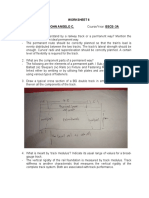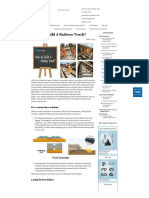Rail Construction 0714
Rail Construction 0714
Uploaded by
pakayaCopyright:
Available Formats
Rail Construction 0714
Rail Construction 0714
Uploaded by
pakayaCopyright
Available Formats
Share this document
Did you find this document useful?
Is this content inappropriate?
Copyright:
Available Formats
Rail Construction 0714
Rail Construction 0714
Uploaded by
pakayaCopyright:
Available Formats
Track Construction
Example of ‘flash butt-welding’
Diagram of a typical rail foundation
MAST
RAIL
BALLAST SLEEPER
BALLAST
TRACK FOUNDATION
NATURAL GROUND
Rail construction is completed over six major stages which include:
A front end loader with a sleeper ‘grab’ attachment
Stage one - Embankment and bridge construction – Much of the Moreton Bay
Rail alignment will be built on earth embankment which will form the rail
foundation (see image below). Bridges and culverts are needed to carry the
rail line over existing roads and water courses and station facilities.
Stage two - Laying concrete sleepers – concrete rail sleepers are placed along
the rail alignment as a base support for the rail. Sleepers are positioned by a
front end loader with a sleeper ‘grab’ attachment which picks up a set of sleepers
and lays them in the configuration for the rail tracks to then be attached.
Stage three - Laying the rail tracks – the steel rail is placed on top of the concrete
sleepers and clipped into place by either a track mountable machine or by hand.
The rail is then welded together using ‘flash butt-welding’ which melts two rail
pieces together forming a seamless rail track.
Stage four - Ballast – ballast is a specific type of rock used for supporting the
sleepers and rail track, keeping them in place while trains run. A ballast machine
rides the new tracks and places the ballast over the sleepers and between the
tracks.
Stage five - Settling the rail – a track mountable machine called a tamping
machine rides along the new track, lifting the tracks, to then vibrate the ballast
into place. It then sets the track into its final position. This method is repeated
numerous times to ensure the rail line settles and is ready for operation.
Stage six - Installing over-head equipment – masts are installed along the rail
alignment to support the equipment which provides electricity to operate trains.
Signalling structures are also installed along the rail route.
You might also like
- HO Railroad From Start To Finish (Model Railroad Handbook, No 36)Document92 pagesHO Railroad From Start To Finish (Model Railroad Handbook, No 36)Sebastián Matías Chacón100% (3)
- LX6 2020 354Document444 pagesLX6 2020 354Esteban Pinto100% (2)
- Alignment of Steam TurbineDocument5 pagesAlignment of Steam Turbineanas100% (2)
- Relay Logic Diagram (Classic Control) : Sheet No. 1Document3 pagesRelay Logic Diagram (Classic Control) : Sheet No. 1Aya Khaled0% (1)
- Pump Sizing Calculation: Tag No. Description Date by Checalc P-101 Feed Pump 28-Jan-15Document2 pagesPump Sizing Calculation: Tag No. Description Date by Checalc P-101 Feed Pump 28-Jan-15anto3harrish3fdoNo ratings yet
- Track Construction: Example of Flash Butt-Welding'Document1 pageTrack Construction: Example of Flash Butt-Welding'Anonymous 2QqKxJJNo ratings yet
- Railconstruction0714 PDFDocument1 pageRailconstruction0714 PDFArvinta PinemNo ratings yet
- Railconstruction0714 PDFDocument1 pageRailconstruction0714 PDFRaj BharathNo ratings yet
- Track Construction: Example of Flash Butt-Welding'Document1 pageTrack Construction: Example of Flash Butt-Welding'Akshay ThakurNo ratings yet
- Track Construction: Example of Flash Butt-Welding'Document1 pageTrack Construction: Example of Flash Butt-Welding'TsukomaruNo ratings yet
- Class Lecture # 1Document32 pagesClass Lecture # 1api-3718532No ratings yet
- Lesson 5 - Structural Design of Railways and PavementsDocument12 pagesLesson 5 - Structural Design of Railways and PavementsAlyssa NavarroNo ratings yet
- Track (Rail Transport)Document13 pagesTrack (Rail Transport)Jefri PerdanaNo ratings yet
- Worksheet 6Document3 pagesWorksheet 6John Angelo CompetenteNo ratings yet
- Liljencrantz2007 WimDocument9 pagesLiljencrantz2007 WimAnh Đức Trần LêNo ratings yet
- Artigo TESEDocument20 pagesArtigo TESESaymo Wendel de Jesus Peixoto VianaNo ratings yet
- Fatigue Life Evaluation of A Through-Girder Steel Railway Bridge PDFDocument10 pagesFatigue Life Evaluation of A Through-Girder Steel Railway Bridge PDFDhimas Surya NegaraNo ratings yet
- Coimbatore Railway: Kanishka.TDocument6 pagesCoimbatore Railway: Kanishka.TAravindhanNo ratings yet
- Non-Linear Shape-Finding Analysis of A Self-Anchored ..Document13 pagesNon-Linear Shape-Finding Analysis of A Self-Anchored ..uzairidrees001No ratings yet
- Slab Track Design For High-Speed PDFDocument11 pagesSlab Track Design For High-Speed PDFwan marzukiNo ratings yet
- Construction of Rio Colorado BridgeDocument10 pagesConstruction of Rio Colorado Bridgedewei chenNo ratings yet
- Bridge TrussDocument22 pagesBridge TrussAjay KumarNo ratings yet
- Case Study Cable Stayed Bridge 5 PagDocument5 pagesCase Study Cable Stayed Bridge 5 PagBravo Paytano BryanNo ratings yet
- Presentation On Construction of Cable Stay Minor Bridge: Presented byDocument14 pagesPresentation On Construction of Cable Stay Minor Bridge: Presented byRahul Kumar VishwakarmaNo ratings yet
- Repair of Two Riveted Steel Plate GirderDocument8 pagesRepair of Two Riveted Steel Plate GirderAbdurrasheed OlugbadeNo ratings yet
- Buna Bak Muhakkak Asphalt Kıyas4Document4 pagesBuna Bak Muhakkak Asphalt Kıyas4Mücahit AtalanNo ratings yet
- Setting Up A Real-Time Train Load Monitoring System in The UK Using Bridge Weigh-In Motion Technology - A Case StudyDocument4 pagesSetting Up A Real-Time Train Load Monitoring System in The UK Using Bridge Weigh-In Motion Technology - A Case StudyFarhad HuseynovNo ratings yet
- R-103 Railroad DesignDocument26 pagesR-103 Railroad Designnuonkoseyla25No ratings yet
- Porr Slab Tarck PresentationDocument44 pagesPorr Slab Tarck PresentationRavindran KNo ratings yet
- Cable Stayed BridgeDocument66 pagesCable Stayed Bridgeshakil_manandhar5399100% (1)
- Lecture 5 - Railways and TracksDocument77 pagesLecture 5 - Railways and Tracks2023125787No ratings yet
- The Launching of River Esk Bridge PDFDocument12 pagesThe Launching of River Esk Bridge PDFVaqas HussainNo ratings yet
- Design For WeldingDocument14 pagesDesign For WeldingJoaquinNo ratings yet
- How To Build A RailwayDocument4 pagesHow To Build A RailwayRavidu LakshanNo ratings yet
- Foot Over Bridge - R0 - 10.05.2024 - R0Document32 pagesFoot Over Bridge - R0 - 10.05.2024 - R0Avishek DeyNo ratings yet
- Slab Track DesignDocument107 pagesSlab Track DesignSivaneswaran Sabaratnam100% (2)
- CVE 06 Highway and Railroad Engg 7 Design of Railway Track and PavementDocument7 pagesCVE 06 Highway and Railroad Engg 7 Design of Railway Track and PavementasalabsanNo ratings yet
- Suspension BridgeDocument20 pagesSuspension BridgeЭнхсайханБат-ОчирNo ratings yet
- Crawler Crane PDFDocument191 pagesCrawler Crane PDFmajdi jerbiNo ratings yet
- Challenging Construction and Erection Methods For The Izmit Bay Suspension Bridge and The 3rd Bosphorus BridgeDocument10 pagesChallenging Construction and Erection Methods For The Izmit Bay Suspension Bridge and The 3rd Bosphorus BridgeMassimo Averardi RipariNo ratings yet
- Rail Structure Interaction For Multiple Span Railway Viaducts With Direct FIXED TRACKDocument10 pagesRail Structure Interaction For Multiple Span Railway Viaducts With Direct FIXED TRACKsandeep tanavadekarNo ratings yet
- Modelling of A Cable-Stayed Bridge For DynamicDocument15 pagesModelling of A Cable-Stayed Bridge For DynamicTanjil MominNo ratings yet
- Eot Crane During SeismicDocument12 pagesEot Crane During SeismicboyzesNo ratings yet
- Technical Transition of Earth Structures For ShinkansenDocument12 pagesTechnical Transition of Earth Structures For ShinkansenManish KumarNo ratings yet
- Arch Bridges - BKKDocument167 pagesArch Bridges - BKKGeetesh MalhotraNo ratings yet
- Non-Linear Earthquake-Response Analysis of Long Span Cablestayed Bridge ApplicationDocument14 pagesNon-Linear Earthquake-Response Analysis of Long Span Cablestayed Bridge ApplicationTanjil MominNo ratings yet
- HSC Engineering StudiesDocument13 pagesHSC Engineering StudiesRick ThuranNo ratings yet
- Analysis of Cable Stayed BridgeDocument30 pagesAnalysis of Cable Stayed BridgeSijan ShresthaNo ratings yet
- Cable and ArchDocument45 pagesCable and Archabubakarsadiiq.engNo ratings yet
- CAPSTONE PROJECT suspension bridge 5Document24 pagesCAPSTONE PROJECT suspension bridge 5itxaman986No ratings yet
- Biondi Et Al 2005Document11 pagesBiondi Et Al 2005Saymo Wendel de Jesus Peixoto VianaNo ratings yet
- RBE Microproject Deep MandokarDocument12 pagesRBE Microproject Deep Mandokar39 - Deep MandokarNo ratings yet
- 2014-THFui2007-Statics and Dynamics Structural AnalysisDocument13 pages2014-THFui2007-Statics and Dynamics Structural AnalysisRamin ShojaNo ratings yet
- Ivvvn: D. T. Robinson. Horse-Car Pole. No. 61,021Document2 pagesIvvvn: D. T. Robinson. Horse-Car Pole. No. 61,021asdfasfNo ratings yet
- Report Truss Bridge 160716155917 PDFDocument65 pagesReport Truss Bridge 160716155917 PDFStefanoNo ratings yet
- Analysis of The Vibration Mitigation Characteristics of The Ballasted Ladder Track With Elastic ElementsDocument19 pagesAnalysis of The Vibration Mitigation Characteristics of The Ballasted Ladder Track With Elastic ElementsMohammed MahmoudNo ratings yet
- Midas Civil - PSBG Railway 3Document43 pagesMidas Civil - PSBG Railway 3Marc Arjo MontelibanoNo ratings yet
- Determination of Hanger Installation Procedure For ....Document18 pagesDetermination of Hanger Installation Procedure For ....uzairidrees001No ratings yet
- A Guide to Some of the Equations used in Constructing a Suspension BridgeFrom EverandA Guide to Some of the Equations used in Constructing a Suspension BridgeNo ratings yet
- A Short Guide to the Types and Details of Constructing a Suspension Bridge - Including Various Arrangements of Suspension Spans, Methods of Vertical Stiffening and Wire Cables Versus Eyebar ChainsFrom EverandA Short Guide to the Types and Details of Constructing a Suspension Bridge - Including Various Arrangements of Suspension Spans, Methods of Vertical Stiffening and Wire Cables Versus Eyebar ChainsNo ratings yet
- Introduction of the Locomotive Safety Truck Contributions from the Museum of History and Technology: Paper 24From EverandIntroduction of the Locomotive Safety Truck Contributions from the Museum of History and Technology: Paper 24No ratings yet
- OhioBrass - 26-HiLite Transmission IsolatorsDocument36 pagesOhioBrass - 26-HiLite Transmission Isolatorslduong4No ratings yet
- Tolco Fire Protection Complete CatalogueDocument77 pagesTolco Fire Protection Complete CataloguepinchipinchiNo ratings yet
- 01 Complete Pulping SolutionsDocument28 pages01 Complete Pulping SolutionsGabriel T. BastosNo ratings yet
- Drilling Progress Dashboard 25 AugDocument6 pagesDrilling Progress Dashboard 25 AugajaykrsinghpintuNo ratings yet
- Vacuum PumpDocument9 pagesVacuum PumpsuranovoleksandrNo ratings yet
- 3 Hours / 100 Marks: Seat NoDocument6 pages3 Hours / 100 Marks: Seat NoomNo ratings yet
- Training Survey For Potential Controlling Energy V2.0Document41 pagesTraining Survey For Potential Controlling Energy V2.0hoenoeyNo ratings yet
- Vacuum EngineeringDocument2 pagesVacuum EngineeringRanchojiNo ratings yet
- ISO 4762 DIN 912 Hexagon Socket Head Cap Screws - VidasanDocument3 pagesISO 4762 DIN 912 Hexagon Socket Head Cap Screws - Vidasany2k405 kaosNo ratings yet
- Engr 3321 Ps 8 Lomibao Darwin ADocument8 pagesEngr 3321 Ps 8 Lomibao Darwin ADarwin LomibaoNo ratings yet
- Sintech Pumps For Sugar Processing PlantDocument18 pagesSintech Pumps For Sugar Processing Plantsahildhingra100% (3)
- Hydraulic-Schematic - CopiDocument2 pagesHydraulic-Schematic - CopiANTA Servicios100% (2)
- Induced & Forced Draft Fan Logic SystemDocument40 pagesInduced & Forced Draft Fan Logic SystemAshwani DograNo ratings yet
- W09 Assignment 5 Staircase DrawingsDocument2 pagesW09 Assignment 5 Staircase Drawingsfarohaxx252No ratings yet
- EV Insulated Toolkit Trolley, Electric Vehicle Insulated Safety ToolkitDocument3 pagesEV Insulated Toolkit Trolley, Electric Vehicle Insulated Safety ToolkitTaherNo ratings yet
- Orbitrol Repairing1Document22 pagesOrbitrol Repairing1Islam ShoukryNo ratings yet
- Wire Rope CertificateDocument2 pagesWire Rope CertificateMarc ObetNo ratings yet
- 20230616-Boq Str. For Tender-Asa Cafe BaliDocument7 pages20230616-Boq Str. For Tender-Asa Cafe BaliAmelia IndriannNo ratings yet
- Parts EMT10TF1 15339BDocument124 pagesParts EMT10TF1 15339BAlex PerexNo ratings yet
- TCCL Plant SpecificationDocument273 pagesTCCL Plant SpecificationThaigroup CementNo ratings yet
- TRIAQUA 80 Spare Parts List (Low Resolution)Document2 pagesTRIAQUA 80 Spare Parts List (Low Resolution)Ivo NikolovNo ratings yet
- DIY Plastic Spoon LampDocument2 pagesDIY Plastic Spoon LampJOANNE NG SIEW LING MoeNo ratings yet
- Operation Manual: Lipstick Moulding Machine With Accessories Mod. LIPFIL-3AL-1Document77 pagesOperation Manual: Lipstick Moulding Machine With Accessories Mod. LIPFIL-3AL-1Kevin Ocomatl100% (1)
- MM34 Web PDFDocument68 pagesMM34 Web PDFPrima Jaya Telolet 082233218700No ratings yet
- Sero Gypsum Product Catalogue June 2023Document52 pagesSero Gypsum Product Catalogue June 2023Voltage LeRoyNo ratings yet
























































































